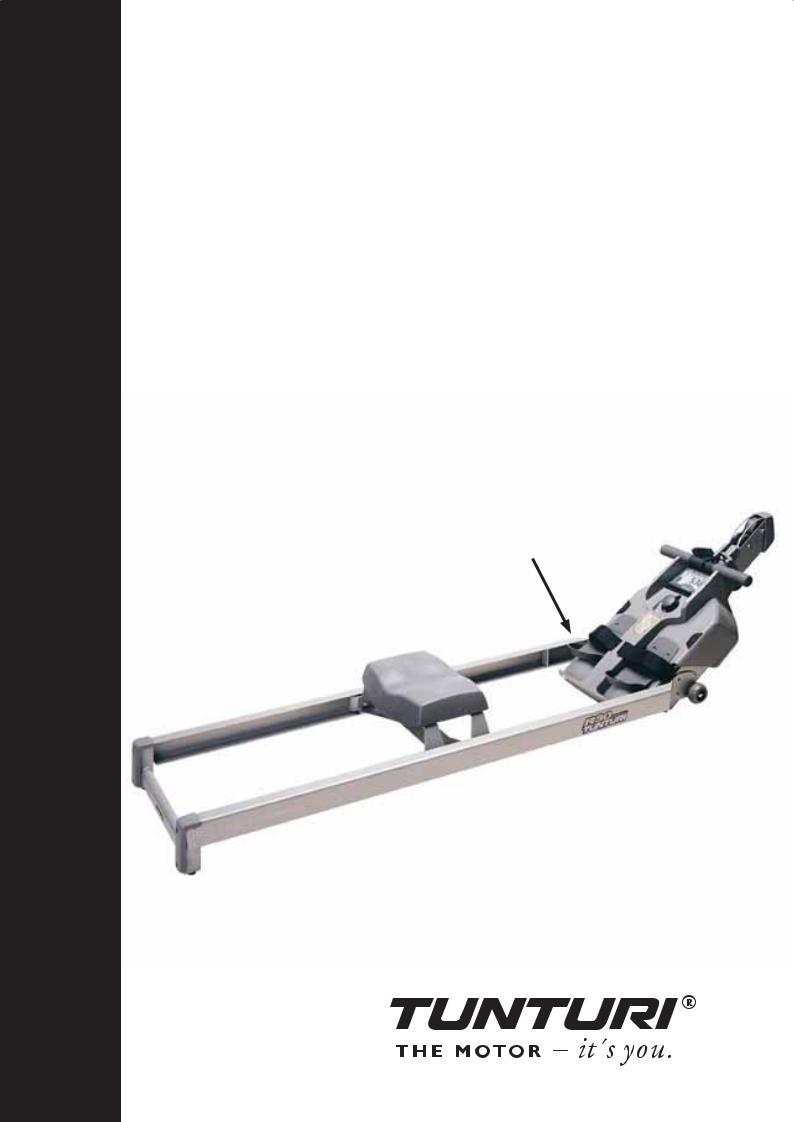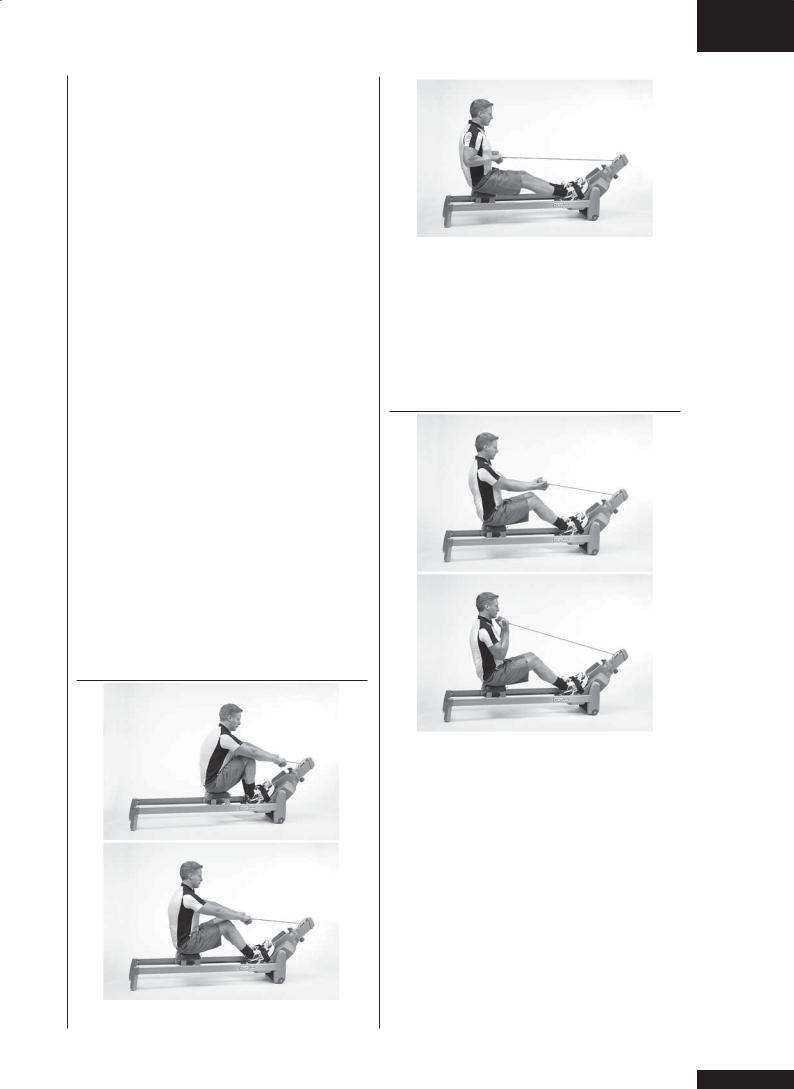Tunturi R30 User Manual

R30 |
OWNER'S MANUAL |
P. 2-8 |
|
||
|
|
|
|
BETRIEBSANLEITUNG |
S. 9-16 |
|
|
|
|
MODE D'EMPLOI |
P. 17-24 |
|
|
|
|
HANDLEIDING |
P. 25-32 |
|
|
|
|
MANUALE D'USO |
P. 33-40 |
|
|
|
|
MANUAL DEL USUARIO |
P. 41-48 |
|
|
|
|
BRUKSANVISNING |
S. 49-55 |
|
|
|
|
KÄYTTÖOHJE |
S. 56-62 |
|
|
|
SERIAL NUMBER
SERIENNUMMER
NUMERO DE SERIE
SERIENUMMER
NUMERO DI SERIE
NÚMERO DE SERIE
SERIENNUMMER
SARJANUMERO
www.tunturi.com

O W N E R ' S M A N U A L • R 3 0
CONTENTS |
|
ASSEMBLY ................................................................ |
3 |
EXERCISING ............................................................. |
4 |
USE ............................................................................ |
4 |
CONSOLE.................................................................. |
6 |
TRANSPORT AND STORAGE .................................. |
8 |
MAINTENANCE ......................................................... |
8 |
MALFUNCTIONS ....................................................... |
8 |
TECHNICAL SPECIFICATIONS................................. |
8 |
IMPORTANT SAFETY INSTRUCTIONS
Read this guide through carefully before assembling, using or servicing your fitness equipment. Please keep the guide somewhere safe; it will provide you now and in the future with the information you need to use and maintain your equipment. Always follow these instructions with care.
YOUR HEALTH
•Before you start any training, consult a physician to check your state of health.
•If you experience nausea, dizziness or other abnormal symptoms while exercising, stop your workout at once and consult a physician.
•Excessive or improper training may cause health problems.
•To avoid muscular pain and strain, begin each workout by warming up and end it by cooling down (slow pedaling at low resistance). Don’t forget to stretch at the end of the workout.
THE EXERCISING
ENVIRONMENT
•The equipment is not to be used outdoors.
•Place the equipment on a firm, level surface. Place the equipment on a protective base to avoid any damages to the floor beneath the equipment.
•Make sure that the exercising environment has adequate ventilation.
To avoid catching cold, do not exercise in a draughty place.
•In training, the equipment tolerates an environment measuring +10°C to +35°C. The equipment can be stored in temperatures ranging between -15°C and +40°C. Air humidity in the training or storage environment must never exceed 90 %.
•Allow at least 100 cm of clearance around the equipment.
THE EQUIPMENT
•If children are allowed to use the equipment, they should be supervised and taught to use the equipment properly, keeping in mind the child’s physical and mental development and their personality. Also make sure that pet animals keep a safe distance to the product when it is transporting or used for training.
•Before you start using the equipment, make sure that it functions correctly
in every way. Do not use a faulty equipment.
•Press the keys with the tip of the finger; your nails may damage the key membrane.
•Never remove the covers.
•Only one person may use the equipment at a time.
•Hold the handlebar for support when getting on or off the equipment.
•Wear appropriate clothing and shoes when exercising.
•Protect the meter from sunlight and always dry the surface of the meter if there are any drops of sweat on it.
•This product has a speed-dependent braking system.
•The equipment has been designed for home use. The Tunturi warranty applies only to faults and malfunctions in home use (24 months). Further information
on warranty terms can be found in the warranty booklet included with the product.
2

Please note that the warranty does not cover damage due to shipping or negligence of adjustment or
maintenance instructions described in this manual.
•The equipment must not be used by persons weighing over 135 kg.
•Do not attempt any servicing or adjustments other than those described in this guide. Everything else must
be left to someone familiar with the maintenance of electromechanical equipments and authorised under the laws of the country in question to carry out maintenance and repair work.
SAVE THIS INSTRUCTION MANUAL
WELCOME TO THE WORLD OF TUNTURI
EXERCISING!
Your choice shows that you really want to invest in your well being and condition; it also shows you really value high quality and style. With Tunturi Fitness Equipment, you’ve chosen a high quality, safe and motivating product as your training partner. Whatever your goal in training, we are certain this is the training equipment to get you there. You’ll find information about using your exercise equipment and what makes for efficient training at Tunturi’s website at WWW.TUNTURI.COM.
ASSEMBLY
Start by unpacking the equipment and check that you have the following parts:
1.Frame and front frame
2.Assembly kit (contents marked with in the spare part list): keep the assembly tools, as you may need them e.g. for adjusting the equipment.
If necessary, please contact your dealer with the model, equipment serial no. and spare part no. of the missing part. You’ll find a spare part list at the back of this guide. The packaging includes a silicate bag for absorbing moisture during storage and transportation. Please dispose of the bag once
you have unpacked the equipment. The directions left, right, front and back are defined as seen from the exercising position.
O W N E R ' S M A N U A L • R 3 0 G B
FRAME AND FRONT FRAME
Turn the front frame bent over the frame up and forward. Attach the front frame to the frame with three screws on both sides: the lowest retaining screw is already in place. Tighten all retaining screws tight. Press the plastic plugs to retaining screw ends.
CONSOLE
Remove the protective cover from the console.
3

O W N E R ' S M A N U A L • R 3 0
Turn the console carefully away from the front frame so that you can remove the battery compartment cover in the back of the console. Open the battery compartment cover carefully from its lower edge. Be careful not to damage the wires. Set the batteries (2 x 1.5V AA) in their place according to the markings in the battery compartment. Reattach the cover and adjust the angle of the console appropriately for exercise.
SEAT
Cut the seat's packaging lock.
EXERCISING
Rowing is a very effective form of exercise. In addition to strengthening the heart and improving circulation, it develops the various groups of
large muscles: the back, the abdomen, the arms, the shoulders as well as the pelvis and the legs. Rowing also develops muscular flexibility without exertion of joints, and it is a recommended form of exercise for those who suffer from pains in the neck and shoulder area. Working out using a rowing machine is excellent aerobic exercise, the principle being that the exercise should be suitably light, but of long duration. Aerobic exercise is based on improving the body’s maximum oxygen uptake, which in turn improves endurance and fitness. The ability of the body to burn fat as a fuel is directly dependent on its oxygen-uptake capacity.
Aerobic exercise should above all be pleasant. You should perspire, but you should not get out of breath during the workout.
You should exercise at least three times a week, 30 minutes at a time, to reach a basic fitness level. Maintaining this level requires a few exercise sessions each week. Once the basic condition has been reached, it is easily improved, simply by increasing the number of exercise sessions.
Exercise is always rewarding for weight loss, because it is the only way of increasing the energy spent by the body. This is why it is always worthwhile to combine regular exercise with
a healthy diet. A dieter should exercise daily
- at first 30 minutes or less at a time, gradually increasing the daily workout time to one hour. You should start slowly and at low resistance, because strenuous exercise may subject the heart and circulatory system to excessive strain. As fitness improves, resistance and speed can be increased gradually.
Short sequences at heavy load increase maximum strength and muscular mass, longer sequences at a lighter load trim the body and develop stamina. First find your maximum heart rate i.e. where the
rate doesn’t increase with added effort. If you don’t know your maximum heart rate, please use the following formula as a guide:
220 - AGE
These are average values and the maximum varies from person to person. The maximum heart-rate diminishes on average by one point per year. If you belong to a risk group, ask a doctor to measure your maximum heart rate for you.
We have defined three different heart-rate zones to help you with targeted training.
BEGINNER: 50-60 % of maximum heart-rate
Also suitable for weight-watchers, convalescents and those who haven’t exercised for a long time. Three sessions a week of at least a half-hour each is recommended. Regular exercise considerably improves beginners’ respiratory and circulatory performance and you will quickly feel your improvement.
TRAINER: 60-70 % of maximum heart-rate
Perfect for improving and maintaining fitness. Even reasonable effort develops the heart and lungs effectively, training for a minimum of 30 minutes at least three times a week. To improve your condition still further, increase either frequency or effort, but not both at the same time!
ACTIVE TRAINER: 70-80 % of maximum heart-rate
Exercise at this level suits only the fittest and presupposes long-endurance workouts.
USE
ADJUSTING RESISTANCE
You can increase or decrease resistance by turning the adjuster knob on the front frame. Turn the adjustment knob clockwise (+ direction) to increase resistance and counterclockwise (- direction) to decrease resistance. The scale above the knob (1-8) helps you find and reset a suitable resistance.
TELEMETRIC HEART RATE MEASUREMENT
The console has a heart rate receiver compatible with Polar equipment, so you can also use
Polar uncoded heart rate belts for heart rate measurement. The most reliable heart rate measurement is achieved with a telemetric device, in which the electrodes of the transmitter fastened to the chest transmit the pulses from the heart to the console by means of an electromagnetic field.
NOTE! If you are fitted with a pacemaker, please consult a physician before using a wireless heart rate monitor.
4

If you want to measure your heart rate this way during your workout, moisten the grooved electrodes on the transmitter belt with saliva or water. Fasten the transmitter just below the chest with the elastic belt, firmly enough so that the electrodes remain in contact with the skin while exercising, but not so tight that normal breathing is prevented. Attach the transmitter and adjust the flexible belt to an appropriate tightness below chest level so that the electrodes are in contact with the skin during exercise. If you wear the transmitter and belt over a light shirt, moisten the shirt slightly at the points where the electrodes touch the shirt. The transmitter automatically transmits the heart rate reading to the console up to a distance of about 1 m.
If the electrode surfaces are not moist, the heartrate reading will not appear on the display. If the electrodes are dry, they must be moistened again. Allow the electrodes warm up properly to ensure accurate heart rate measurement. The transmitter is switched to an active state only when it is being used for measurement. Sweat and other moisture can, however, keep the transmitter in an active state and waste battery energy. Therefore it is important to dry the electrodes carefully after use.
When selecting training attire, please note that some fibers used in clothes (e.g. polyester, polyamide) create static electricity, which may prevent reliable heart rate measurement. Please note that a mobile phone, television and other
electrical appliances form an electromagnetic field around them, which will cause problems in heart rate measurement.
ROWING MOTION
O W N E R ' S M A N U A L • R 3 0 G B
Tighten the footstraps. Take a grip on the bar and start the rowing stroke by leaning slightly forward, with the knees bent and the arms straight. Push yourself backwards straightening your back and your legs simultaneously. Continue the movement until you lean slightly backwards and flex your armsat the same time. Return to the starting position, lean forward and straighten your arms.
BICEPS (ELBOW FLEXORS)
You can develop the biceps while rowing by taking an undergrasp of the bar or in the following way: grasp the bar from underneath, keep your knees straight and your feet under the footstraps. Begin the movement with your arms straight. Bend your arms. You can also develop your biceps by standing in front of the device, grasping either over or under the bar and bending your arms .
5
